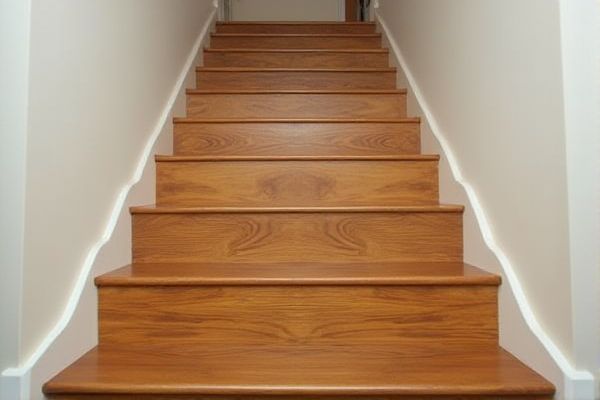
Wood laminate treads offer durability and resistance to scratches and moisture, making them a cost-effective and low-maintenance option compared to solid wood treads, which provide natural beauty, warmth, and can be sanded and refinished multiple times. Explore this article to discover the best choice for your stairs and understand the pros and cons of each material.
Table of Comparison
| Feature | Wood Laminate Treads | Solid Wood Treads |
|---|---|---|
| Material Composition | Composite core with a decorative wood veneer | 100% natural hardwood |
| Durability | Moderate; resistant to scratches and stains | High; can be sanded and refinished multiple times |
| Maintenance | Low maintenance; easy to clean | Requires regular polishing and refinishing |
| Cost | More affordable; budget-friendly option | Higher cost; premium investment |
| Installation | Easy; often click-lock system or glue-down | Requires professional skills; nailing or gluing |
| Appearance | Variety of designs; may lack natural wood grain depth | Authentic wood grain; natural color variations |
| Moisture Resistance | Better resistance; suitable for humid environments | Less resistant; prone to warping if wet |
| Environmental Impact | Uses engineered materials; may include synthetic resins | Biodegradable; sourced from sustainable forestry |
Introduction to Wood Laminate and Solid Wood Treads
Wood laminate treads consist of a high-density fiberboard core topped with a decorative layer that mimics the look of solid wood, offering durability and resistance to scratches and moisture. Solid wood treads are crafted from a single piece of natural hardwood, providing authentic grain patterns, superior strength, and the ability to be refinished multiple times. Choosing between laminate and solid wood treads depends on factors like budget, desired aesthetic, and maintenance preferences.
Material Composition: Wood Laminate vs Solid Wood
Wood laminate treads consist of a composite core topped with a high-resolution photographic layer and a clear protective coating, offering enhanced durability and resistance to scratches and moisture. Solid wood treads are made from a single piece of natural hardwood, providing authentic grain patterns, natural warmth, and the ability to be sanded and refinished multiple times. While wood laminate treads provide a cost-effective and low-maintenance alternative, solid wood treads deliver superior aesthetic appeal and long-term value due to their genuine material composition.
Durability and Longevity Comparison
Wood laminate treads offer enhanced resistance to scratches, moisture, and wear, making them a durable choice for high-traffic areas compared to solid wood treads. However, solid wood treads boast a longer lifespan due to their ability to be sanded and refinished multiple times, preserving their natural beauty over decades. Your decision should consider the balance between ease of maintenance and the potential for long-term restoration when evaluating durability and longevity.
Aesthetic Appeal and Design Options
Wood laminate treads offer a wide range of aesthetic appeal with versatile design options, including various colors, patterns, and finishes that mimic exotic hardwoods at a more affordable price. Solid wood treads provide authentic natural grain and rich textures, enhancing the warmth and character of any space while allowing for custom staining and finishing to match specific decor styles. Both options deliver unique visual qualities, but laminate excels in design flexibility, whereas solid wood brings timeless elegance and depth.
Installation Process: Ease and Requirements
Wood laminate treads feature a straightforward installation process, often utilizing click-lock systems or adhesive backing, which reduces time and the need for specialized tools. Solid wood treads demand more precise measuring, cutting, and securing with nails or screws, requiring professional expertise and additional equipment. The ease of installing laminate treads makes them a popular choice for DIY projects, while solid wood treads offer a traditional finish but with higher labor and skill requirements.
Maintenance Needs and Care Tips
Wood laminate treads require less maintenance than solid wood treads due to their protective wear layer that resists scratches and moisture. Solid wood treads need regular polishing or refinishing to maintain their appearance and prevent damage from humidity and wear. Proper cleaning with a damp cloth and avoiding excessive water are crucial for both types to prolong their lifespan and preserve aesthetic appeal.
Cost Analysis: Laminate vs Solid Wood Treads
Wood laminate treads offer a more budget-friendly option compared to solid wood treads, with laminate generally costing 30-50% less per square foot while maintaining a wood-like appearance. Solid wood treads provide superior durability and refinishing potential, which can add long-term value despite their higher initial cost. Your choice depends on balancing upfront investment with expected longevity and maintenance preferences.
Environmental Impact and Sustainability
Wood laminate treads typically have a lower environmental impact due to their efficient use of materials and the ability to incorporate recycled wood fibers, reducing deforestation compared to solid wood treads. Solid wood treads, while biodegradable and renewable, often require harvesting mature trees, contributing to habitat loss and increased carbon emissions if not sourced from sustainably managed forests. Choosing FSC-certified or reclaimed options for both types enhances sustainability by promoting responsible forestry and minimizing waste.
Safety and Slip Resistance
Wood laminate treads typically offer enhanced slip resistance due to their textured surface finishes and protective coatings, reducing the risk of slips and falls on stairs. Solid wood treads, while naturally attractive, can become slippery when polished or worn, necessitating additional treatments or non-slip pads to ensure safety. Your choice should consider the stair usage environment and the balance between aesthetic appeal and optimal slip-resistant performance for everyday security.
Choosing the Right Tread for Your Staircase
Wood laminate treads offer a cost-effective and durable alternative to solid wood treads, featuring an easy-to-maintain surface resistant to scratches and moisture. Solid wood treads provide natural beauty, unique grain patterns, and the ability to be sanded and refinished multiple times, enhancing longevity and aesthetic appeal. Selecting the right tread depends on factors like budget, expected foot traffic, maintenance preferences, and the desired style for your staircase.
 homyna.com
homyna.com